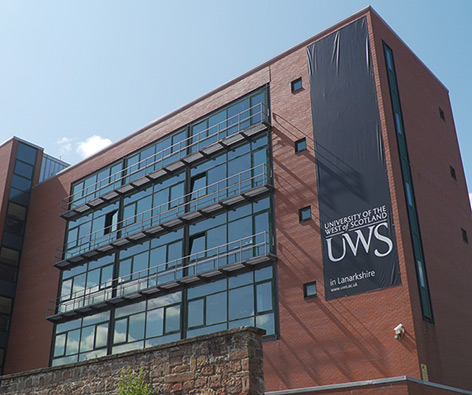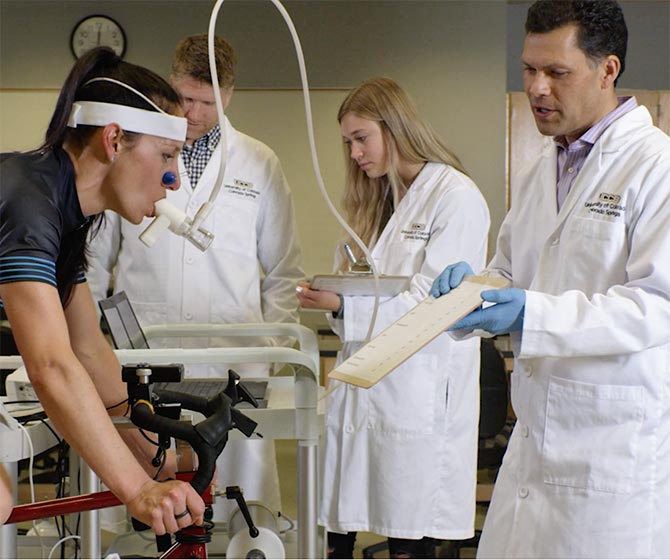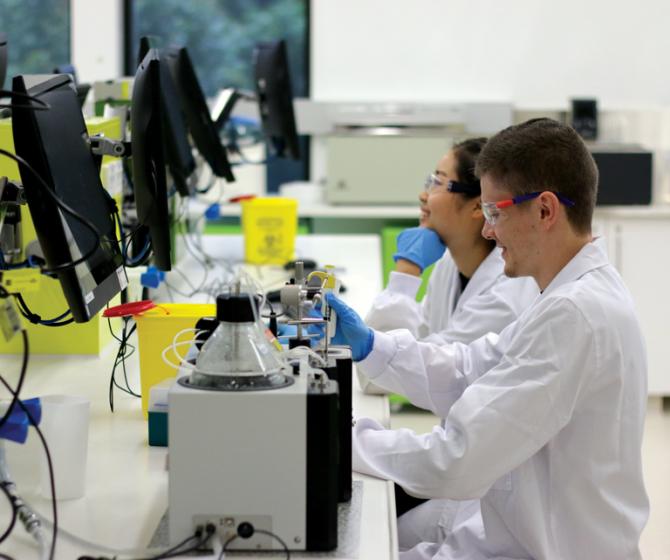Dr. Bridget Ford is an Assistant Professor in the Department of Biology at The University of the Incarnate Word (UIW) in Texas, and has been teaching for more than 10 years. As the coordinator for two large introductory anatomy and physiology courses, Bridget, like so many other educators, was swept up in the hectic switch to online learning in 2020.
Luckily, she had heard about Lt at a professional workshop earlier that year, and was able to start using the online physiology and anatomy labs soon after!
We sat down with Bridget to talk about how she came to be an educator, how she taught anatomy and human physiology labs online during the pandemic, and what she sees in the future for her lab curriculum.
Twin passions: science and teaching
Bridget runs a research laboratory on diabetic kidney disease, but you’ll catch her in the classroom just as often as at a lab bench. Growing up, her love for explaining science led her to pursue teaching opportunities alongside her PhD. “My main draw was to get my PhD and be at a primarily teaching institution. At UIW, this was my first official faculty position where I was able to marry the research I do with what I'm doing in the classroom, and recruit students from my courses."
"Having them come into the lab space, where they can start to mature into scholars who are asking questions, troubleshooting and engaging, extending beyond what they've done in the classroom: I think that has been my favorite aspect of being at UIW.”
The supportive environment fostered at UIW, with an undergraduate student cohort of around 4000, means that Bridget can use a hand-on approach when teaching students, many of whom she comes to know personally.
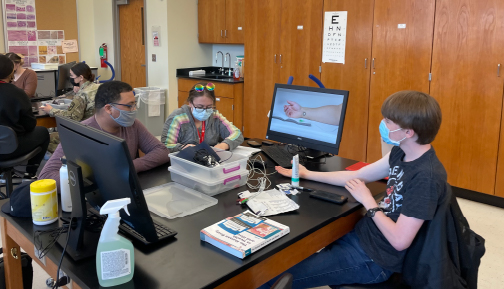
Students in Dr. Ford's class complete online physiology lab activities using Lt.
Curiosity and independence are important assets for any student of science, and Bridget seeks to nurture these qualities in her classes. “With teaching, my favorite moments include being in the lab with students when things start to click. They’ll say “Oh my gosh, this was in our lecture course and it's making sense now. I can actually see it happening.”
In courses like anatomy and physiology, there is a real need to link theory with practical demonstrations. When students learn about muscle tension and contraction, authentic data acquisition is a must. “We talk about how muscle contraction occurs, and then they actually get to see a readout on a screen of the process happening in real time. So I think, for me, those are my favorite moments: when they start connecting the dots. Because that was also my favorite part of being a student, when suddenly everything starts to fall together and it makes sense.”
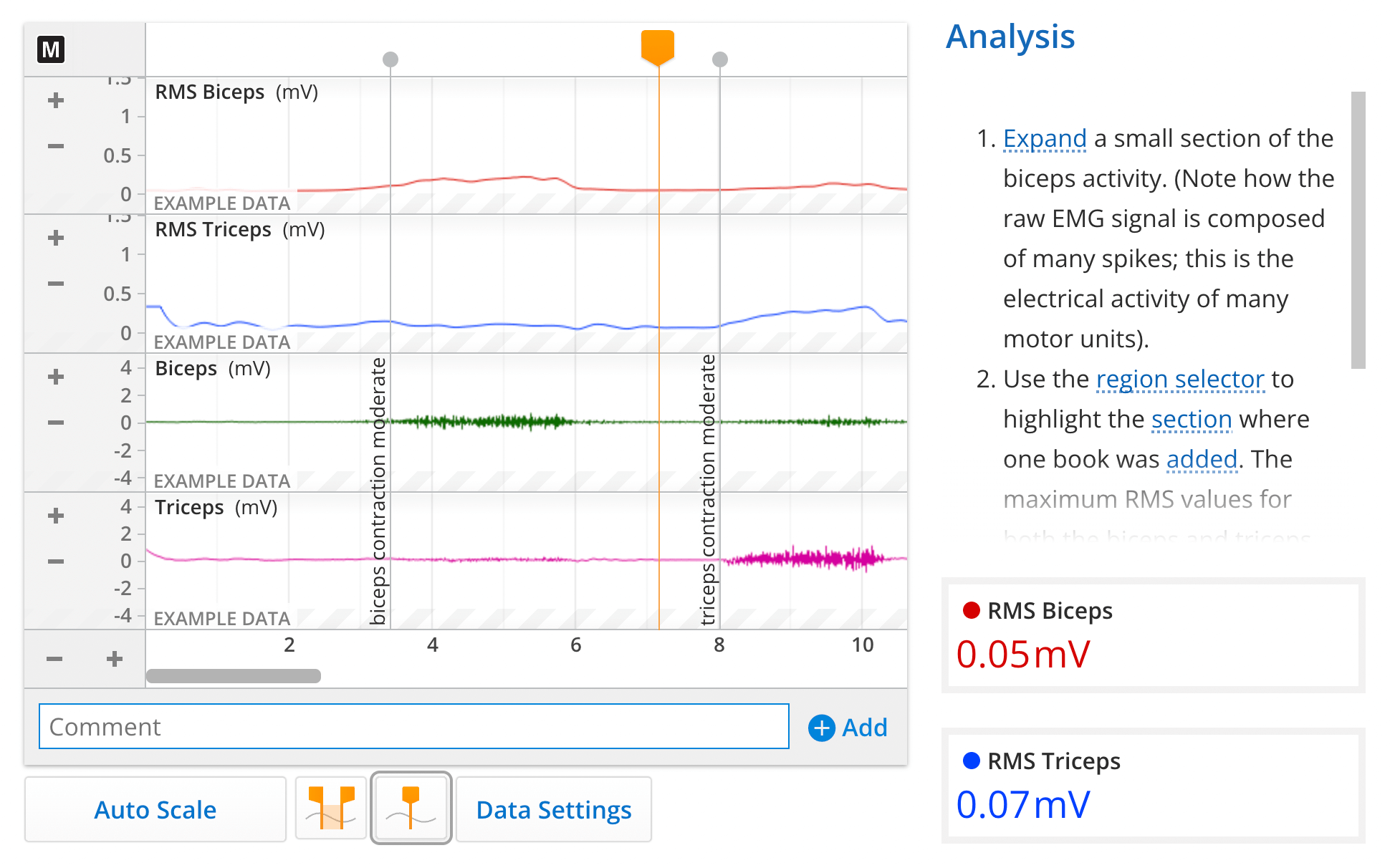
Example data in an online physiology lab in Lt, "Muscle and EMG".
COVID, chaos, and creating a curriculum
While Bridget was already an experienced educator, she took over as anatomy and physiology course coordinator in the fall of 2019, right before COVID played havoc with education across the world. While she initially was looking to overhaul the largely kit-based curriculum, which she felt was not challenging enough for students, COVID meant that she had to implement whatever was at hand. “I’d already started making some small adjustments to the curriculum I inherited that semester. I was trying to do more engaging things, and then I ended up having to throw it all away because we had to move online.”
In this first semester - which she has called a “dumpster fire” - the UIW team pieced together an anatomy and physiology online course using a variety of digital tools. This patchwork approach served its purpose for emergency remote teaching, but once it became clear that COVID was going to be around for the long haul, Bridget and the team decided to use Lt to create a cohesive online lab curriculum for the second semester.
That summer, the team piloted online anatomy and physiology labs in Lt with a single section of students in both A&PI and A&PII, before moving to the Fall semester and using the platform with 20+ sections. The courses address a wide range of anatomy and physiology topics, but Bridget was able to find content for the majority of her learning outcomes in the existing Content Library.
Related: Lt Human Physiology Collection »
“What I liked about Lt the most as an educator and as someone who's having to develop the curriculum for our labs, was that it really was an all-in-one approach. Everything I needed was in the program - I didn't have to do a whole lot outside of using Lt.”
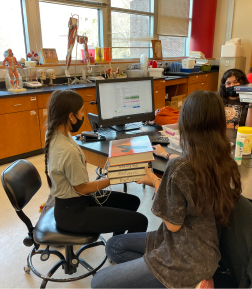
Students in Dr. Ford's class complete online physiology lab activities using Lt.
Support from Arianna, her Customer Success Manager, also meant that Bridget felt confident to train other faculty. “Because I had such a really great experience learning about how to use Lt before my classes, I now run a workshop before each fall semester to train new adjunct faculty.”
To take some pressure off these faculty members, students in the A&P courses are asked to complete the Lt Student Starter lesson before they come into the lab, making sure that they’re familiar with the software and hardware, and ensuring more time is spent on the interactive anatomy and physiology content, rather than troubleshooting.
Most of the students in these courses are non-majors, looking to gain admission to professional courses, like nursing. This means that they don’t often have a lot of experience with anatomy and physiology before they arrive in class, and poses a slight problem for Bridget. “So I’m coming in with my biology hat thinking “This is great! This is all amazing,” and I roll it out to the students and they're like “No, this is a fire hose coming at me!”. Editing the content meant that both non-major and major students could be appropriately challenged, but “getting that balance right took about two semesters”.
Let’s get physical: The importance of face-to-face lab experience
Because students weren’t on campus in 2020, the anatomy and physiology team at UIW relied on videos and photos to recreate the labs online. The existing dissection videos in the Anatomy Collection, as well as self-made videos showing data collection and analysis with the PowerLab and Lt tools, meant that the UIW team could give students as close an experience to being in the lab as possible.
Find out more: How to use Lt's example data to teach labs remotely »
However, it can’t be denied that in “embodied” disciplines like anatomy and physiology, lab skills are essential. They are typically a key learning outcome, and this is true of Bridget’s anatomy and physiology lab curriculum, which focuses on “training students how to think, and training them in techniques that they can use later in graduate school or in their careers.”
Now that classes are back on campus, educators are noting the absence of lab skills due to online learning during the pandemic. With the newest group of students Bridget has recruited to her lab, “many have expressed that “I never learned how to pipette, I never learned how to work in the lab at all,” because they've been doing nothing but virtual simulations."
"While those are great and a good stand-in, it's really important that they can still learn the actual technique, so we've been spending time just learning how to do things like that.”
With physical labs in session, students are able to have the best of both worlds: they can go into the lab and collect their own physiological data, or, for certain sections, they can work online. “As soon as we were back in person, we could really enjoy the full experience Lt can offer. It was especially exciting when we did EEG and they had each other hooked up to the sensors and electrodes. That, for me, was a really great moment in the classroom because you could see how excited they were about it.”
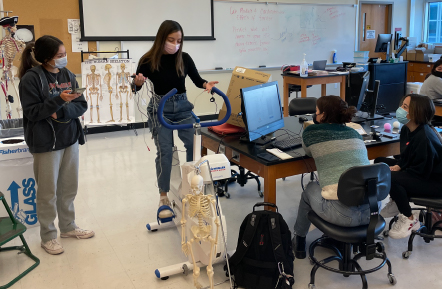
Students in Dr. Ford's class complete online physiology lab activities using Lt.
Exposing students to physiological hardware like the PowerLab also contributes to training competent research scientists. Bridget’s original goal, even before COVID complicated the global education landscape, was to overhaul the old kit-based curriculum. “Beefing up the scientific rigor was definitely a big plus for us. My hopes, and the overall outcomes for the program, are for students to be able to predict and analyze data - and that just was really missing from our prior approach using different kits."
"By incorporating the PowerLab - and now we’re using Lt Sensors, which make the setup easier - these tools get the same powerful data and powerful experience.”
Related: Lt Sensors for Human Physiology »
Checking student understanding
Although the existing lab courses don’t have practical summative assessments, they do use regular formative assessments. Students complete the review and integration pages of each Lt lab to benchmark their understanding.
In the future, Bridget plans to establish new summative assessments in Lt, which will ask students to describe lab procedures and identify anatomical structures. “Anecdotally, in terms of how they're doing with Lt, I feel like the students have a good grasp of the material; they're able to address the challenges that we give them within the lesson; and I would say that they're hitting all of the objectives and outcomes that we want.”
Bringing online learning into the laboratory
Most educators in North America have, begrudgingly or not, used technology to teach in the last two years. Bridget can understand why some people resist online tools and will only go as far as uploading PowerPoints. “I think for some faculty members, they feel that their approach has been working for years - the students are learning really well and they're still engaged in the classroom - so the educators are going to keep the same methods.” But she points out some compelling benefits of classroom tech:
1. Convenience - An online physiology course offers flexibility - a major learning from the pandemic. “From my experience, the students really appreciate being able to incorporate technology into their learning. Even with things like our asynchronous prelabs, students could use their phones to complete them, and that made it a lot more convenient.”
2. Student buy-in - In today’s world, students of any discipline are immersed in technology in their everyday lives. “With something like Lt, it’s an interactive program that makes students feel like they’re doing something that is state-of-the-art.”
3. Preparing for research careers - There are students using “PowerLabs for data acquisition who are going to continue using that equipment in their future research careers. We have a lot of students who are already doing undergrad research, so the technology just helps to augment the student experience.”
Related: Teaching through COVID19: Dos and Don’ts »
Looking ahead to 2022 and beyond
Having made so many big changes to their anatomy and physiology lab activities in such a short space of time, 2022 offers UIW faculty an opportunity to take stock, consolidate, and refine. Bridget is confident in her curriculum and eager to build it out further. “Oh definitely, we will continue using Lt for the foreseeable future! I can't envision using any other program.”
“Now that we have time to breathe after rushing to get online, I’m excited to explore the other available modules and lessons. I’ve had a great experience using Lt, and that's really the whole impetus behind writing the [original] blog article: I want other educators to know about the success we've had with it and to know that other people should be using it.”
Enjoy this story? Check out Bridget’s original article on her transition to online teaching on LifeSciTRC. You might also be interested in how Wendy Riggs from the College of the Redwoods, California, used Lt Sensors to flexibly teach physiology online.
Related: Understand Your Physiology - Our active online-learning resource for physiology students »
Dr. Bridget Ford is an Assistant Professor in the Department of Biology at The University of the Incarnate Word (UIW) in Texas, and has been teaching for more than 10 years. She teaches Anatomy and Physiology I and II, General Biology I and Lab for Majors, Cell Biology, and a Special Topics course in Endocrinology at UIW. Her research focuses on renal cell injury in diabetic kidney disease.


